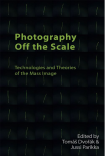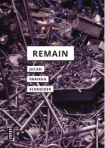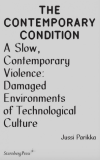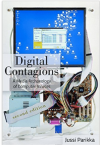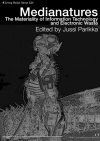Archive
Queuing
This is a chapter from a couple of years back but reading something today on queuing (as ordering, waiting, allocating, as Celia Lury puts it in her wonderful new book Problem Spaces) made me return to it and also post here. The chapter on “Underpinning Time” focuses on questions of microtemporality that creates publics or collectives as being modulated through cultural techniques of of temporality in networks. While the chapter is far from a full-fledged take on queuing, of standing in line and waiting for ones turn, it starts with the core scene that defines also a certain moment of network time/allocation of packets in traffic.
“The Underpinning Time” came out in the collection Digital Memory Studies edited by Andrew Hoskins.
Virality and Digital Contagions
The publisher of my book Digital Contagions: A Media Archaeology of Computer Viruses (2nd updated edition, 2016) has given free access to the preface by Sean Cubitt and my Introduction to the book. The download can be accessed on the publisher’s website.
From Sean Cubitt’s opening words:
“There is a disturbing etymological puzzle underlying the title. “Contagion” appears to be a late fourteenth-century coinage, appearing in the wake of the Black Death in mediaeval French and Middle English, from the Latin roots “con,” meaning “with,” and “tangere,” the active verb “to touch.” The puzzle comes from another word we associate at least equally closely with electronic media, “contact.” Here the root words are the same, with the only exception that “contact” comes from the passive form “tactum,” “to be touched.” Oddly, most people probably feel positive connotations about “contact,” but negative connotations from “contagion.” We have had six hundred years to develop these connotations, and yet there remains a nub of their origins: the contagious principle of something coming to touch us or to touch us together is more subjective than the principle of contact, where any two things could be brought together. The usefulness of the electrical contact as a major metaphor, dating back through early electrical experiments and familiar from the literature of the pioneering days of motoring and aviation, gives it both a certain objectivity and a sense of familiarity that we bring into the realm of communicative contact. Not so contagion, even though it is very close, at least etymologically.”
In this context, it might be also relevant to mention the piece the French publication AOC commissioned us with Tony Sampson to write on different models of virality and media.
Here’s the link to the French version.
And Boundary 2 Online published the English version: The New Logics of Viral Media.
Tap My Head, Mike My Brain: Experiencing Digital Culture
March 7th, Tuesday, we will be launching our new books with Tony Sampson in London. Tony’s wonderful study The Assemblage Brain and my Digital Contagions (2nd, revised edition with a new preface by Sean Cubitt that can also be read for free online) will form the context for our short talks under the broad rubric of “experiencing digital culture”.
A short description below and to book tickets (free) see Eventbrite. Kings College London and their Arts & Humanities Research Institute are hosting the event.
We’ve worked with Tony since our joint edited book The Spam Book: On Viruses, Porn and Other Anomalies from the Dark Side of Digital Culture, which I still feel is a timely book with a pretty impressive cadre of writers such as Matthew Fuller and Andrew Goffey (on evil media!), Steve Goodman, Luciana Parisi, Susanna Paasonen, Greg Elmer, Alex Galloway, Eugene Thacker and many others. Ever since, I’ve always gotten a lot out from following Tony’s work, and same applies to his new book.
I also wrote the blurb for The Assemblage Brain and can warmly recommend it:
‘Tap my head and mike my brain’; Tony Sampson’s new book might silently echo Pynchon’s famous lines, but this is also an original, inspiring, and theoretically savvy take on the culture of the affective brain, from sciences to business, cybernetics to political power. Warmly recommended.
Description
After Arikan: Data Asymmetry
After our succesful exhibition of Burak Arikan’s work, Data Asymmetry, I am posting some of the interviews and material that came out of the exhibition.
Here’s a video interview we did with Arikan setting up the exhibition in the Winchester gallery in November 2016:
And then there’s the interview(s) in Furtherfield: Carleigh Morgan interviewed Burak in the part 1 of the interview about Data Asymmetry and myself in part 2 of the interview. The interview(s) address mapping as a collective experiment, networks as events, (art) methodologies of working with data and a lot of other topics related to internet culture.
Earwitnesses of a Coup Night
Update: This text is published inGerman in the Zeitschrift für Medienwissenschaft‘s blog, translated by Florian Sprenger. It is also published in Turkish in Biamag, translated by Doğan Terzi. Here is the original English version, which is also published on the Theory, Culture & Society journal’s blog.
Earwitnesses of a Coup Night: The Many Media Infrastructures of Social Action
The particularly cruel scenes in Ankara and Istanbul from July 15th and 16th circulated quickly. From eye witness accounts to images detached from their context, media users, viewers and readers was soon seeing the graphic depictions of what had happened with the added gory details, some of them fake, some of them not.
Still and moving images from the hundreds of streams that conveyed a live account of the events left many in Turkey puzzled as to what is going on. Only later most were able to form some sort of a picture of the events with the coherence of a narrative structure. By the morning the live stream on television showed military uniform soldiers raising their hands and climbing down from their tanks. What soon ensued were the by already now iconic images of public punishment: the man with his upper torso bare and the belt as his whip, the stripped soldiers in rows shamed and followed up by the series of images of expressions of collective joy as most of Turkey was relieved again. The coup was over. The unity in resisting the coup was unique. As it was summarised by many commentators: even the ones critical of the governing AK Party’s politics agreed that this was not a suitable manner of overthrowing an elected government.
However, what became evident immediately in the wake of the actual events was the quick spread of narratives and explanations about the coup night and its extent. As one journalist aptly and with a healthy dose of sarcasm put it:

The flux of commentaries on social media and in newspapers, columns and television deserved its own name: “coupsplaining” as @shokufeyesib coined it.
Also some rather established organisations like Wikileaks got quickly on the spectacle-seeking bandwagon of the coup attempt’s repercussions. Turkish journalists and activist soon read and revealed that the so-called “AKPleaks”-documents were not really anything that interesting as it was advertised to be. As Zeynep Tufekci summarised: “According to the collective searching capacity of long-term activists and journalists in Turkey, none of the ‘Erdogan emails’ appear to be emails actually from Erdogan or his inner circle” while actually containing information that could be considered harmful to normal Turkish citizens instead.
Of course, besides commentators inside and outside Turkey, there was no lack of people with first-hand experience. Besides the usual questions that eyewitnesses were asked in many news reports about “how did things look like”, another angle was as pertinent. How did it sound? The soundscape of the coup was itself a spectacle catered to many senses: the helicopters hovering around the city; the different calibre gunfire that ranged from heavy fire from helicopters to individual pistol shots; individual explosions; car horns; sirens, and the roaring F-16 that descended at times so low so that its sonic boom broke windows of flats. Such sonic booms have their own grim history as part of the 21st century sonic warfare as cultural theorist Steve Goodman analysed the relation of modern technologies, war and aesthetics. As has been reported for years, for example Israeli military has used sonic noise of military jets in Palestine as a shock technique: “Palestinians liken the sound to an earthquake or huge bomb. They describe the effect as being hit by a wall of air that is painful on the ears, sometimes causing nosebleeds and ‘leaving you shaking inside’.”
In the midst of sonic booms, a different layer of sound was felt through the city: the mosques starting their extraordinary call to prayer and calls to gather on the streets. The latter aspect was itself triggered by multiple mediations that contributed to the mobilization of the masses. Turkish President had managed to Facetime with CNN-Turk’s live broadcast and to call his supporters to go on the streets to oppose the coup attempt. By now even the phone the commentator held has become a celebrity object with apparently even $250,000 offered for it.
But there was more to the call than the ringtone of an individual smartphone. In other words, the chain of media triggers ranged from the corporate digital videotelephony to television broadcasting to the infrastructures of the mosques to people on the streets tweeting, filming, messaging and posting on social media. All of this formed a sort of a feedback-looped sphere of information and speculation, of action and messaging, of rumours and witnessing. Hence, there was more than just traditional broadcast or digital communication that made up the media reality of this particular event.
The mosques started to amplify the political leadership’s social media call by their own acoustic means. Another network than just social media was as essential and it also proved to be irreducible to what some called the “cyberweapon” of online communications. As one commentator tried to argue commenting on the events in Turkey: “But, this is the era of cyberpower. Simply taking over the TV stations is not enough. The Internet is a more powerful means of communication than TV, and it is more resilient — especially with a sophisticated population.” However, there were also other elements in the mix that made it a more interesting and a more complex issue than merely about the “cyber”.
Turkish artist and technologist Burak Arikan had already in his earlier work mapped the urban infrastructure of Istanbul in terms of its mosques, malls and national monuments. “Islam, Republic, Neoliberalism” (2012) employs his critical mapping methodology to visualise how structures of power are part of the everyday whether we always realise these relationships or not. Based on his research, Arikan devised three maps of those architectural forms and how they connect. According to Arikan, the “maps present a comparative display of network patterns that are formed through associations linking those architectural structures that represent the three dominant ideologies –Islam, Republic, Neoliberalism– in Turkey.”
During the coup weekend, it was the network of the mosques and their minarets that became suddenly very visible – or actually, very audible. While the regular praying times have become such an aural infrastructure of the city that one does not necessarily consciously notice it, the extraordinary calls from imams reminded how dense this social, architectural fabric actually is. The thousands of Istanbul mosques became itself an explicit “sonic social network” where the average estimated reach (300 meters) of sound from the minarets is too important of a detail to neglect when one wants to understand architecture as solidifying social networks in contemporary Turkey. In the context of mid-July it was one crucial relay of communication between the private sphere in homes, the streets and the online platforms contributing to the mobilization of the masses. The musicological perspective has highlighted how sound and noise negotiate conflict across private and the public and we can extend this to a wider media ecological perspective too. This is where art and design practices can have an instrumental role to play in helping us to understand such overlapped media and sensorial realities.
Artists such as Arikan have investigated the ways how online tools and digital forms of mapping can connect to issues of urban planning and change. The visual artwork helps us to also understand how there are other social realities, less front of our eyes even if they are in our ears. This expands the wider sense of how media is and was involved in Turkey’s events, and it gives also insights to new methodologies of artistic intervention in understanding the coupling of media, architecture, visual methods and the sonic reality of urban life. And in this case of the bloody events of the coup weekend, much of the personal experience of “what happened” is now being narrated in Turkey in terms of what it sounded like – another aspect of the media reality of the coup attempt’s aftermath.
Google DNS Freedom Fight: 8.8.8.8
In the midst of the past (less than) 24 hours of Turkey’s Twitter-blockade, we have seen a flood of tweets, comments, analysis and information – a lot of them, paradoxically, from Turkey. Some operators might not have yet been quick enough to shut down access, and at the same time people have found access via alternative means. The situation has again meant an increase in people’s understanding of the internet and looking into how DNS works as well as VPN’s. Indeed, tips were spread online to assist Turkish people – such as the three simple methods. And information was passed offline too – demonstration of a yet another connection of the streets and the online.
 That people are able to bypass the DNS-based censorship is one thing to ponder about – especially because the new internet law in Turkey would allow other measures too. But what Geraldine Juárez pointed out on Twitter was of course this: 8.8.8.8. points to Google Public DNS. Corporate freedom services, the rhetorics of net freedom, etc. play as part of this wider scenario where alternatives to authoritarian nationalist politics seem to be the Corporate system. And that it’s pretty odd/scary/eerie that this gets rather automatically picked up as the political alternative, even to the extent of Google becoming infrastructurally used as the politically “open alternative” – or just more bluntly, as “Freedom”:
That people are able to bypass the DNS-based censorship is one thing to ponder about – especially because the new internet law in Turkey would allow other measures too. But what Geraldine Juárez pointed out on Twitter was of course this: 8.8.8.8. points to Google Public DNS. Corporate freedom services, the rhetorics of net freedom, etc. play as part of this wider scenario where alternatives to authoritarian nationalist politics seem to be the Corporate system. And that it’s pretty odd/scary/eerie that this gets rather automatically picked up as the political alternative, even to the extent of Google becoming infrastructurally used as the politically “open alternative” – or just more bluntly, as “Freedom”:
In such situations, one does need quick and dirty solutions – infrastructural affordances, whether corporate or not, need to be taken into use for short-term goals; but in terms of the wider political situation of networks – networkpolitics on the level where infrastructure meets the political imaginary – this leads into rather an odd choice between “closed” and “open” that does not imply as clear of a choice as one would assume based on the older political vocabularies. This is indeed not to downplay the significance of this sort of activism – distributing DNS information on streets, as in the image below. It is just to ask the fundamental questions regarding political choice, alternatives and how much the lack of alternatives is increasingly attempted to be hardwired into a material actualisation of the lack of political imaginary: “no choice but”.
Update [March 22, 2014]: Turkish government has now blocked access to Google Public DNS too.
– related reading includes (of course)
Evgeni Morozov’s analysis of network politics and its relation to Silicon Valley but also Benjamin Bratton’s work on “the stack” and the changing political nomos in the age of planetary computation.
No Such Agency: Kittler on the NSA
Friedrich Kittler’s words seem prophetic, telling the story of metadata and its politically sustained unreachability: “Maybe Jagger was wrong. We can always get what we want, from CDs to cable TV. Just not what we need: information on information. The fact that currents of media desires flow camouflages a situation in which information technology is strategy.
Paul Feigelfeld has done a great thing and translated Friedrich Kittler’s text “No Such Agency” from 1986 into English. What seems a rather visionary move – to talk of the NSA technological surveillance activities in the 1980s already – is just a proof of the German media theorists ability to perceive the intimate link modern forms of intelligence and technology have. Below our short intro to the translation, written together with Paul:
Introduction to Kittler’s “No Such Agency”
by Paul Feigelfeld and Jussi Parikka
German media theorist Friedrich Kittler’s short text on the NSA (National Security Agency) titled “No Such Agency” was originally published in 1986. The German newspaper and online publication TAZ decided to publish the piece from its archives in January 2014, after months of heated discussion about the NSA after the Snowden leaks. What the piece reveals is less the idea that Kittler should be branded a visionary, but that the NSA has a long technological history.
The text is a sort of a review of, or at least inspired by, James Bamford’s book The Puzzle Palace: Inside the National Security Agency, America’s Most Secret Intelligence Organization (1983) and its German translation, NSA. Amerikas geheimster Nachrichtendienst, which came out in German in 1986.
At the time, Kittler had just fought through Aufschreibesysteme: 1800-1900 as his habilitation, and Gramophone, Film, Typewriter was looming. More significantly, however, he had just bought his first computer and taken up programming. Like Kittler, the Arpanet was slowly switching to UNIX and C as a technical standard, before the internet of the 1990s. In Germany during the 1970s, BKA chief Horst Herold had implemented “Rasterfahndung” or dragnet policing as a countermeasure to the RAF (Red Army Faction) threat. And as Kittler demonstrates in his text, the NSA’s role of power in information infrastructures was not a reaction to the internet, but an act of design within those systems.
The piece shows Kittler’s interest in secrecy and the military basis of media technologies – but significantly, it reminds us that the media theorist was always as interested in institutions as their technical networks of knowledge.
 Photographer Trevor Paglen, famous for his photographic mapping of networks and sites of power in the post 9/11 US, and recently his NSA photography, argues how “secrecy ‘nourishes the worst excesses of power’” . But for Kittler, one could say that secrecy is power: the technically mediated possibilities of circulation, restriction and gathering of information way before the Internet and much before Edward Snowden was able to give us a further insight into the extensive contemporary forms of surveillance excessively interested in us humans. For Kittler, however, this already marks the possibility that the information gathering and processing machines are at some point not anymore even interested in human targets: “With the chance of forgetting us in the process.”
Photographer Trevor Paglen, famous for his photographic mapping of networks and sites of power in the post 9/11 US, and recently his NSA photography, argues how “secrecy ‘nourishes the worst excesses of power’” . But for Kittler, one could say that secrecy is power: the technically mediated possibilities of circulation, restriction and gathering of information way before the Internet and much before Edward Snowden was able to give us a further insight into the extensive contemporary forms of surveillance excessively interested in us humans. For Kittler, however, this already marks the possibility that the information gathering and processing machines are at some point not anymore even interested in human targets: “With the chance of forgetting us in the process.”
Read Kittler’s “No Such Agency” here.
Preempting Dissent in Istanbul
We (as in Winchester School of Art) are supporting a screening of Preempting Dissent in Istanbul, at SALT (November 28, at 20.00). This is the first screening in Turkey.
The new documentary is based on the book of same name by Greg Elmer and Andy Opel. The documentary is best described as “a culmination of a collaborative process of soliciting, collecting and editing together video, still images, and creative commons music files from people around the world. Preempting Dissent interrogates the expansion of the so-called ‘Miami-Model’ of protest policing, a set of strategies developed in the wake of 9/11 to preempt forms of mass protest at major events in the US and worldwide.”
The screening is one of the activities that Winchester School of Art is supporting and organizing in Istanbul currently.
Following the screening in the Walk-in Cinema there will be a Q&A with Greg Elmer and myself. The Q&A will be held in English.
More info on the Facebook page of the event.
A teaser trailer of the documentary.
New Publications
Amodern–journal has a massive special issue on Network Archaeology out now. I was also interviewed for the collection that followed up on the Miami University last year’s conference of the same theme.
Other new publications include a piece from last year. The first version of this paper on dust (Dust and Exhaustion: The Labor of Media Materialism) was given as a keynote for the Canadian Communication Association annual conference in 2012 at Wilfrid Laurier University. Some smaller variations came out in Depletion Design as well as in Artnodes-magazine. This is however a rather long stand-alone piece which narrates through “dust” themes of non-human materialism, digital culture, work and exhaustion: it picks up on themes of exhaustion and nanoparticles, as much as the metal and mining aspects which contribute to the scale in which we can expand our ideas concerning materiality of media culture. Below the first beats of the text.
“Each particle of dust carries with it a unique vision of matter, movement, collectivity, interaction, affect, differentiation, composition and infinite darkness” — Reza Negarestani, Cyclonopedia
I. Dust — The Non-Thing
There is something poetic about dust. It is the stuff of fairy tales, stories of deserted places; of attics and dunes, of places from so long ago they seem to have never existed. Dusty books — the time of the archive that layers slowly on shelves and manuscripts. Marcel Duchamp’s 1920s Large Glass was a compilation of dust. In a way, he allowed dust to do the work: a temporal, slow compiling by the non-human particles as a work of art installed at the museum, “a purposeful inactivity.” [1] Dust can transform, even if it can itself easily escape any grip. It is amorphous, even metamorphic, in the manner Steven Connor describes. [2] There is also a lot of it. It can be done and dusted, removed from sight and forgotten — in need of no further attention. Nanoparticles are everywhere and form societies unseen and unheard of, yet they conglomerate on a scale unimaginable to human beings. We are a minority. They have their say on human things, and cover what we leave behind intentionally or by accident — obsolescent technologies, wrecks, monuments — which remind us not only of these things themselves but of the gradual sedimentation of dust. Dust marks the temporality of matter, a processual materiality of piling up, sedimenting, and — through its own million-year process — transformations of solids to ephemeral and back. It swarms and overwhelms, exhausts and clouds. “Breathe as deeply as you will, dust will never be depleted.” [3]
There is something poetic and sometimes even romantic about lack of breath. Lung diseases are after all a sign of the delicate soul, and have a long cultural history. Tuberculosis features in a vast range of examples from a Puccini opera to Thomas Mann’s The Magic Mountain (1924). The pale tuberculotic body feeds towards the mythical airiness of lungs, blocked by the disease. It is as if tuberculosis releases the body from matter: “TB is disintegration, febrilization, dematerialization; it is a disease of liquids — the body turning to phlegm and mucus and sputum and, finally, blood — and of air, of the need for better air.” [4] But the lung-diseased body is easily exhausted, lacking in air, gasping for it. It is a tired body, and tiredness is one key trajectory we should be following as well: a laboring body.
This is a text about dust as well as exhaustion: about non-human particles as well as labor. It takes small things like dust as one vector for its argument, and as a vehicle in the manner of which we sometimes think through objects. Dust is, however, not quite an object, not in the intuitive sense that objects are supposed to be easily graspable. It does not fit the hand, even if it covers vast terrains. It is more environmental and better characterized as a milieu. Well, almost a milieu: we rarely count it among things that matter, but what if we did? What if we followed dust as a trajectory for theory — theory that is concerned with materiality and media? What if dust is one way to do “dirt research”: a mode of inquiry that crosses institutions and disciplines, and forces us to think of questions of design as enveloped in a complex ecology of economy, environment, work, and skill. Dirt brings noise, as Ned Rossiter reminds us, and dirt research can be understood “as a transversal mode of knowledge production [that] necessarily encounters conflict of various kinds: geocultural, social, political and epistemological.”[5]









